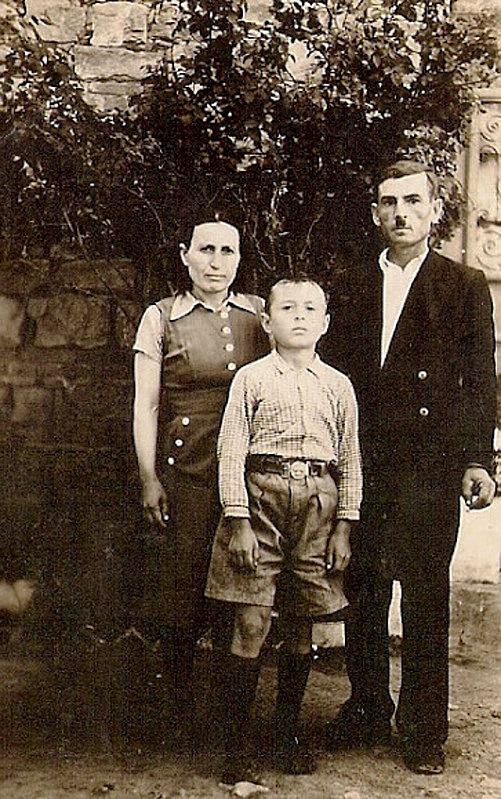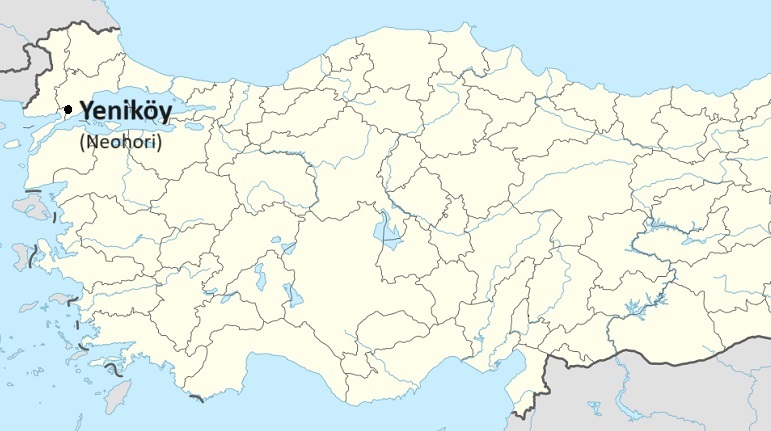
Pictured: Panagiotis Paraskhakis (standing right), Maria Chrysopoulou and Athanasios Paraskhakis.
The following testimony compiled by Arsenis Paraskhakis is based on the testimony of his father Panagiotis Paraskhakis.
Panagiotis Paraskhakis was born in 1909 at Neohori (today Yeniköy) in the Peristasi (Şarköy) and Miriofyto (Mürefte) region of Eastern Thrace. Neohori is situated on the main road that connects Gallipoli and Keşan with Constantinople via Rodosto (today Tekirdağ).
Before 1914, the village was inhabited by 689 people, all of them Greek. The village had three mahallas (neighbourhoods). One of them was named after the church of the Prophet Elias, the other incorporated the school and cafenion (cafe) and the other incorporated a vrisi (public water source) and a big Sycamore tree.

The main occupations of the inhabitants was agriculture and animal husbandry. The main products they produced were wheat, barley, oats, corn, sorghum (lentil-like seed) and large quantities of beans, sesame and anise. They also cultivated many vines from which they produced a lot of wine. My grandfather had a horse-drawn reaper. He had 220 acres of farmland and 4 acres of vines.
On the 27th of July 1911 there was a large earthquake and around 6-7 people died from the village. Neohori celebrated the feast days of Saint Athanasios and the Prophet Elias. On the feast day of the Prophet Elias, two families would purchase a calf then slaughter it and share the food amongst everyone. There were two other purely Greek villages in the region; Limniski (Tr: Gölcük) and Kalo Dentro (Tr: Yayaağaç).
In 1914, 567 of the Neohori Greeks were deported to Vezirhan near Bursa in Asia Minor (300 km away). In 1918, only 275 of them returned. They were first taken to Peristasis (Şarköy) then placed on ships which transported them over to the Asia Minor hinterland. From there they were forced to the interior. The residents of the two other neighbouring purely Greek villages Gölcük and Yayaağaç were also relocated.
The region of Eastern Thrace was temporarily liberated by the Hellenic military in June 1920, however in October 1922 following the Smyrna Holocaust, Eastern Thrace was ceded to Turkey after the Mudanya Armistice. As a result, all the Greeks of Eastern Thrace abandoned their homes and fled. The last president of the village was Agnostis Kalamaras.
They assigned Lionta Kalamara to coordinate the repatriation process. They took quilts, capes, utensils, flour and loaded them onto the cart belonging to Arsenis. The carts were lined up while the elders gazed at their village in tears. They crossed the Evros river in boats and passed Alexandroupolis and Loutro and ended up in the Komotini region at Tselebikio and Karatzakio (Arhontika and Aratas respectively). They worked for some Turks there. The authorities ordered for grain to be distributed to the refugees. A Bey* opposed it and in the evening he was killed. It was a beautiful region but we suffered from malaria and left in October 1923 for Kozani.
Some stayed in Kozani while the rest went to Omali in Kozani. There they were given some wheat and farmland. In Autumn of 1924, they went to Peponia and stayed in temporary accomodation. One room was given to each family. My father built his home in 1932 and married in December 1936.
* Originally a title given to the ruler of a province or region but later used as a general title of respect.
Source: Arsenis Paraskhakis.
Further Reading:
Eastern Thrace: The First Phase of the Greek Genocide
Metropolitan Konstantinos Koidakis
Persecution and Genocide of Hellenism in Thrace
Map of Eastern Thrace
Urge Turks to Massacre all Greeks in Thrace



